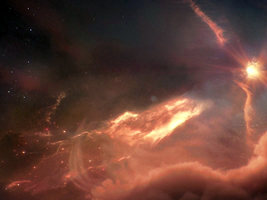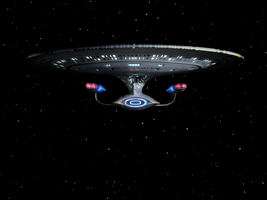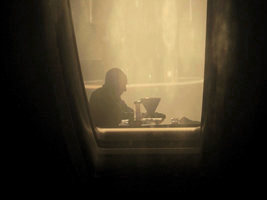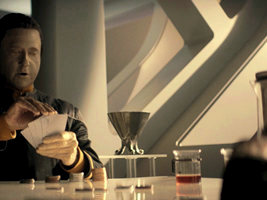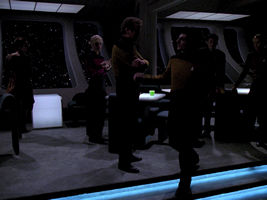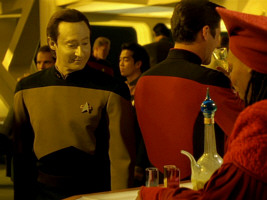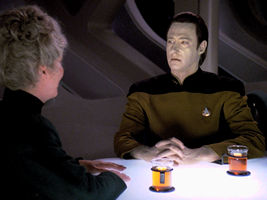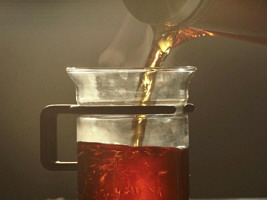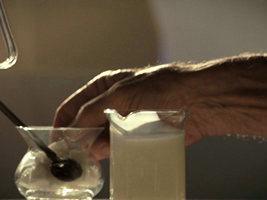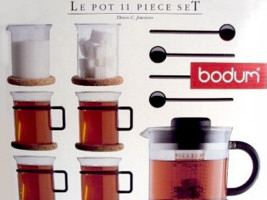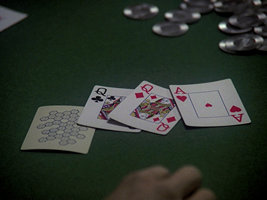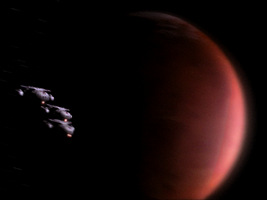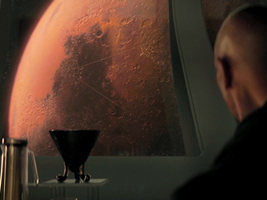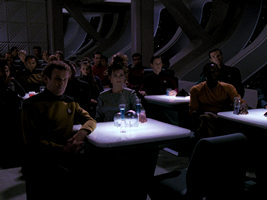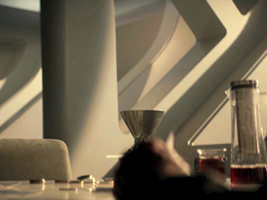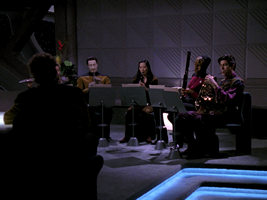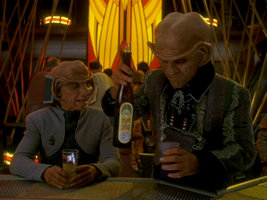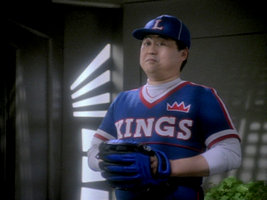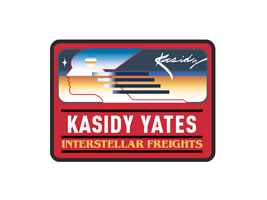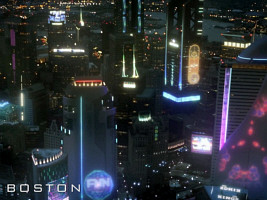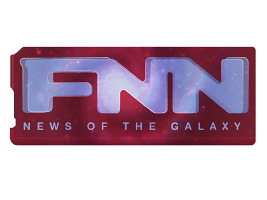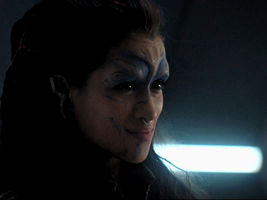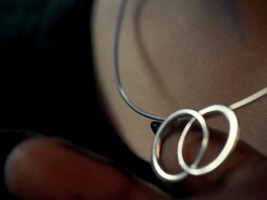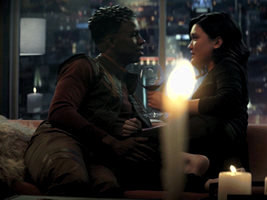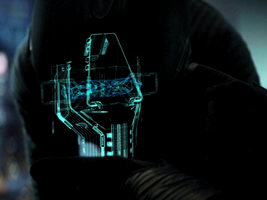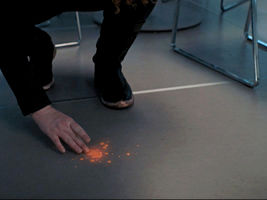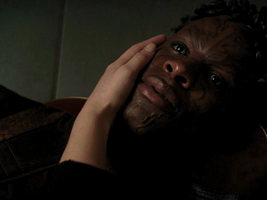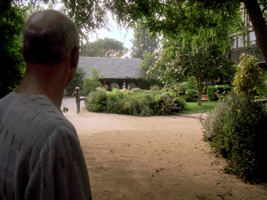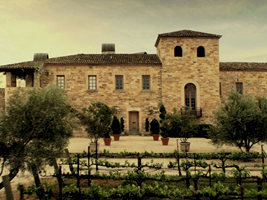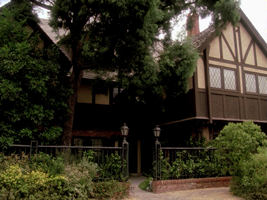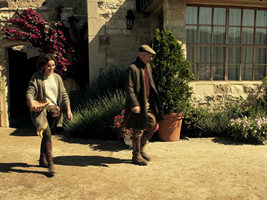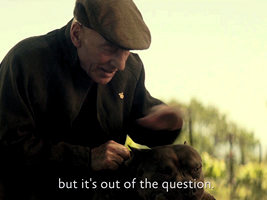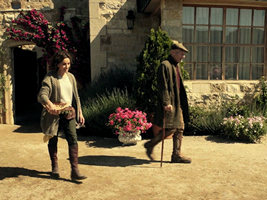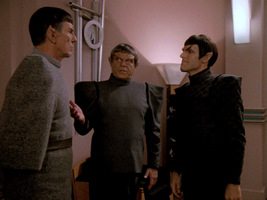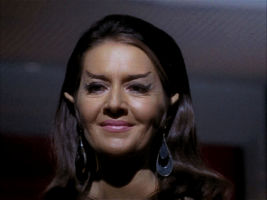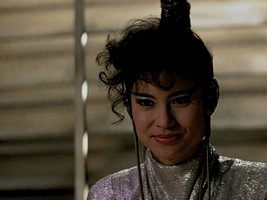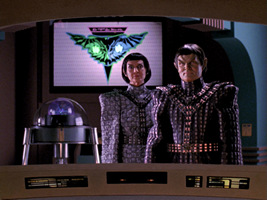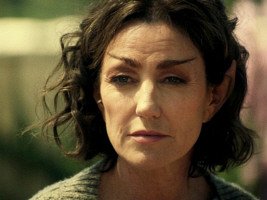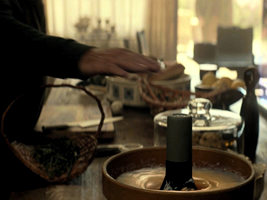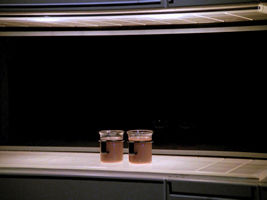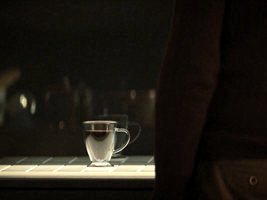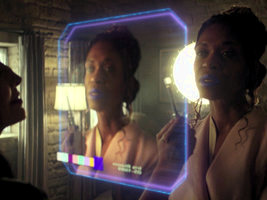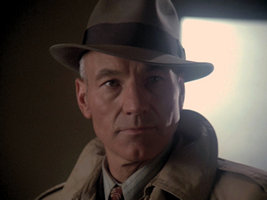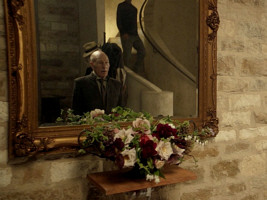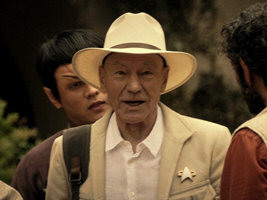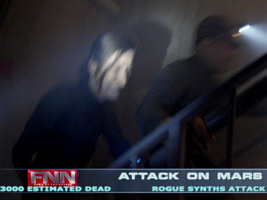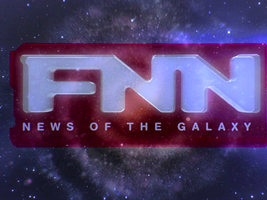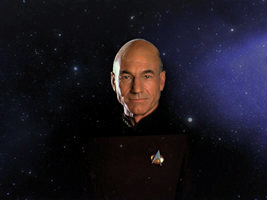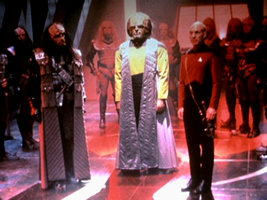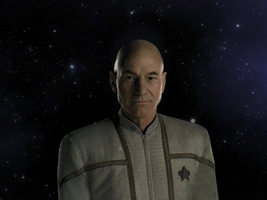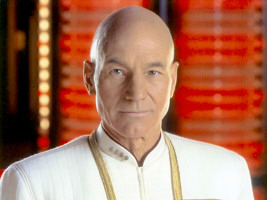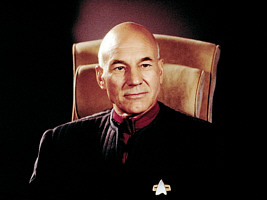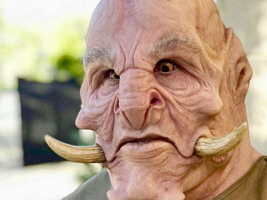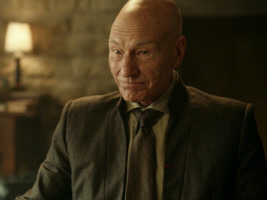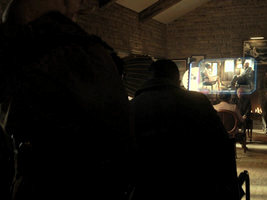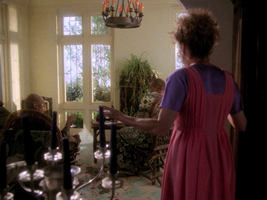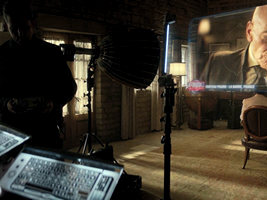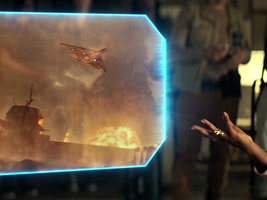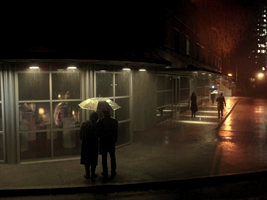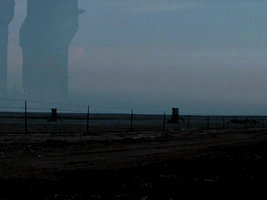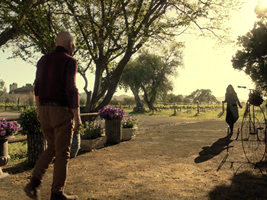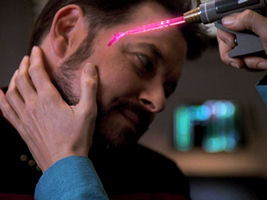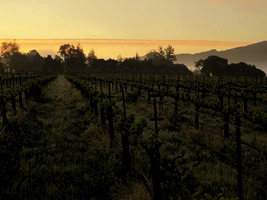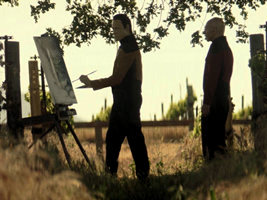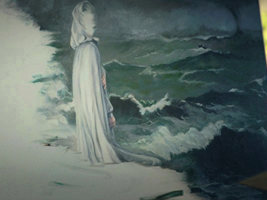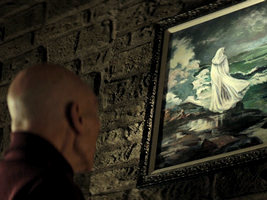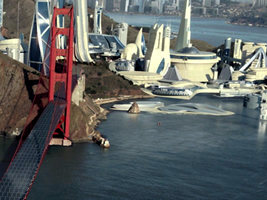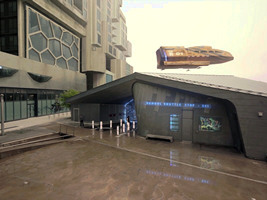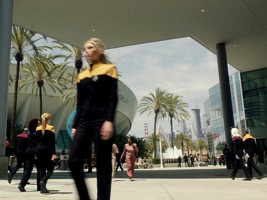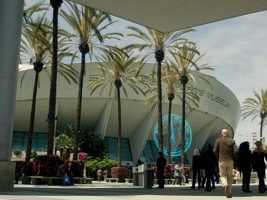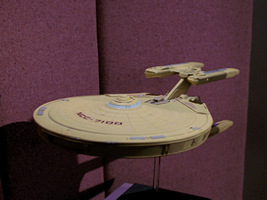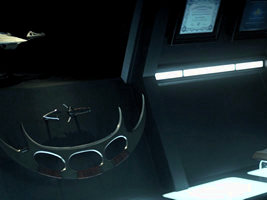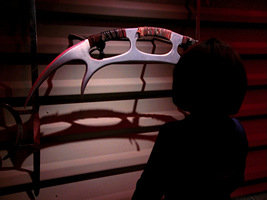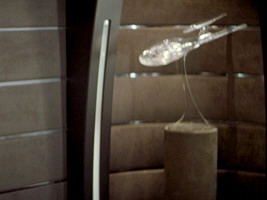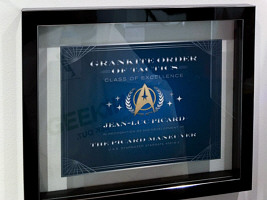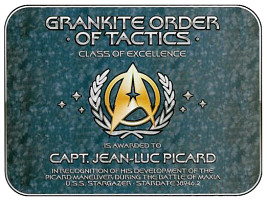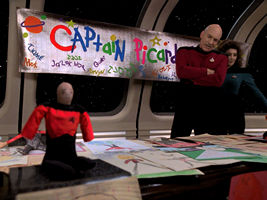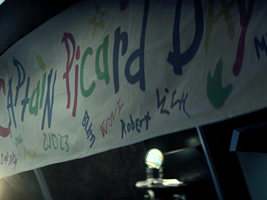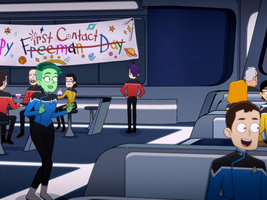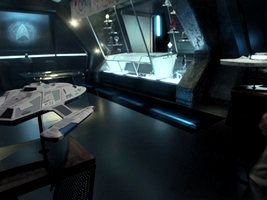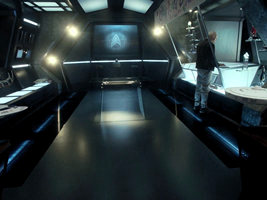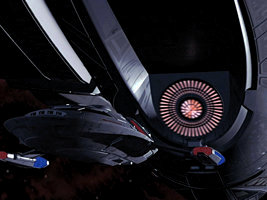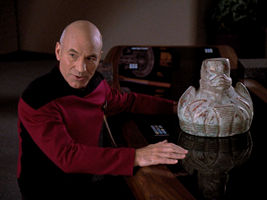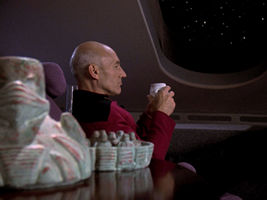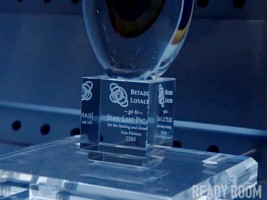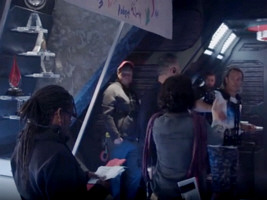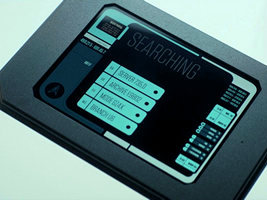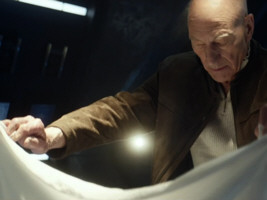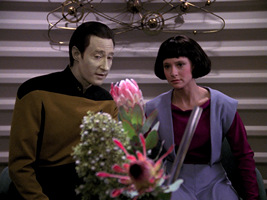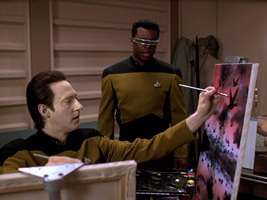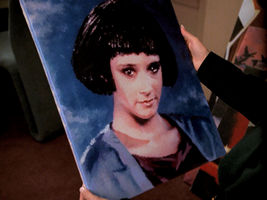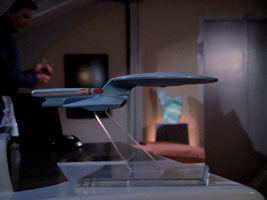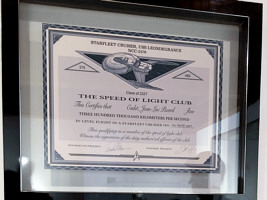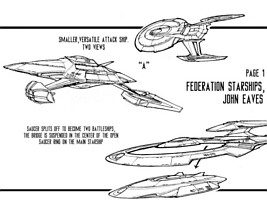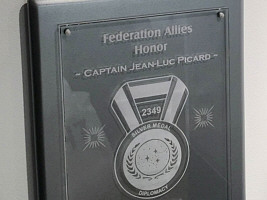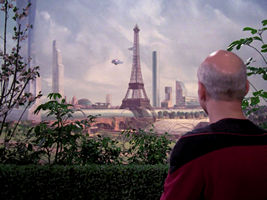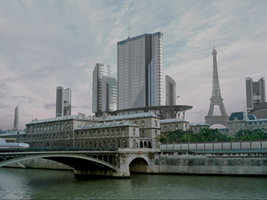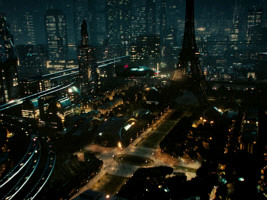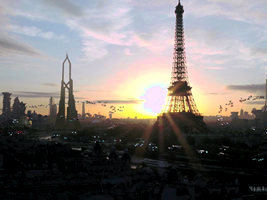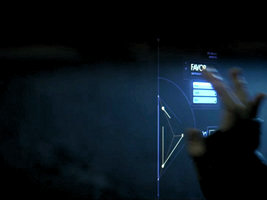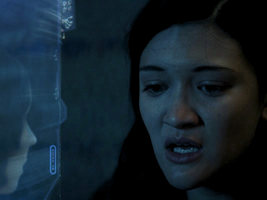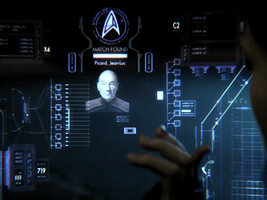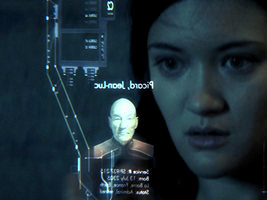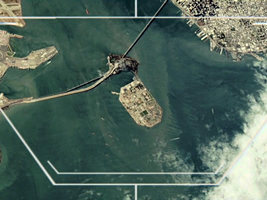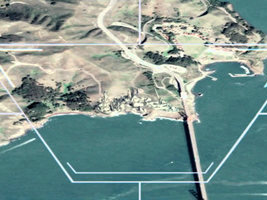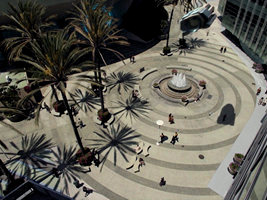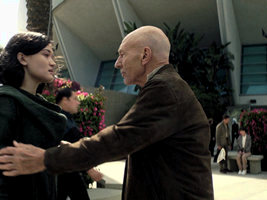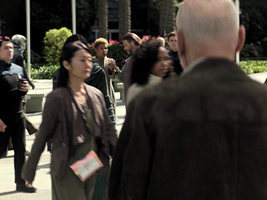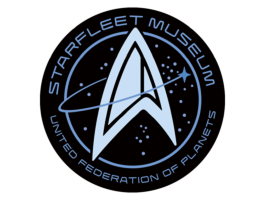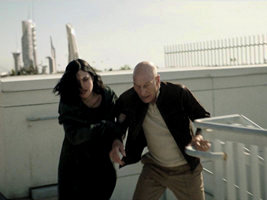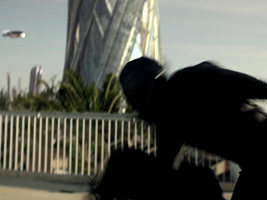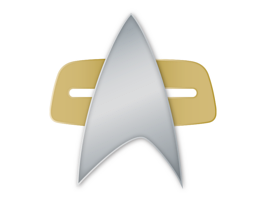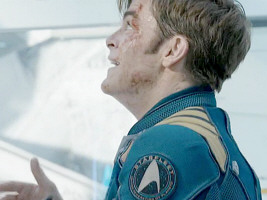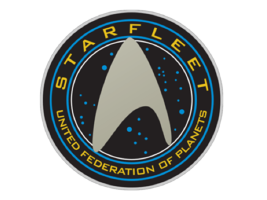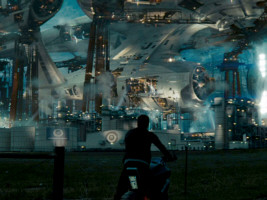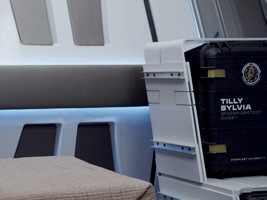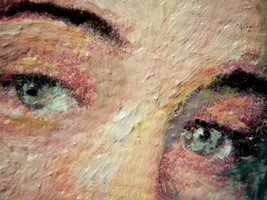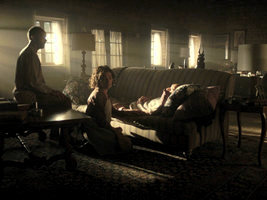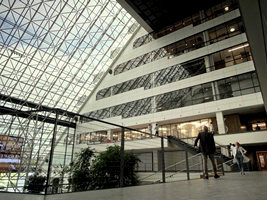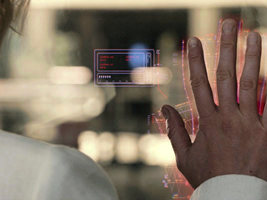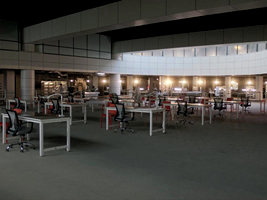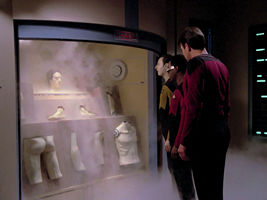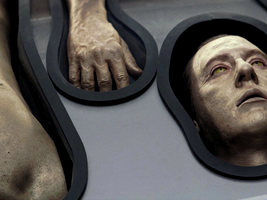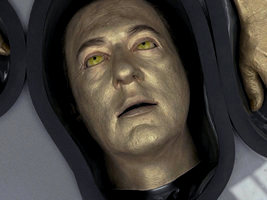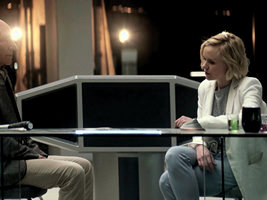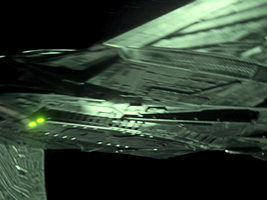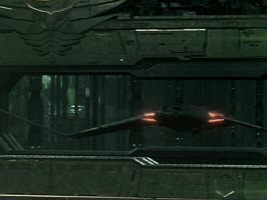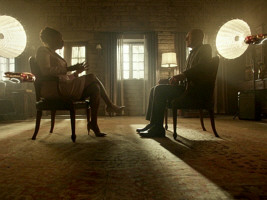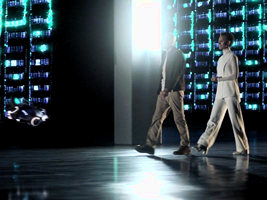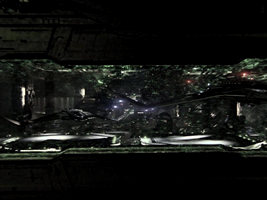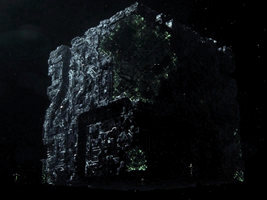Observations in PIC: "Remembrance"
by Jörg Hillebrand and Bernd Schneider
Here are some observations about sets, props, make-ups and visual effects in PIC: "Remembrance", with special attention to continuity with previous Star Trek series and movies.
Chronological List
Observation 01
The TNG series finale, "All Good Things", ends with a poker scene and the USS Enterprise-D flying off into the distance, towards a nebula. "Remembrance" begins with a poker game and the camera approaching the USS Enterprise-D inside a nebula.
The episode opens with "Blue Skies" by Irving Berlin, which of course is a reference to "Star Trek Nemesis". More specifically, it is the version sung by Bing Crosby, the grandfather of Denise Crosby.
Observation 02
Similarly, "Encounter at Farpoint" begins with an outside shot of the USS Enterprise-D and the camera flying towards a forward-facing window with Captain Picard standing behind it. "Remembrance" features the camera approaching a Ten Forward window through which Picard can be seen again.
The windows as seen from the outside are not those of Ten Forward but more on the port side of the ship. A conference lounge may be located here too, but the interior is that of Ten Forward. The window sizes are equal on the outside, whereas the central window is wider and hence correct on the rebuilt Ten Forward set. Only those three windows are illuminated on the outside, whereas there are nine on the inside.
Another inaccuracy is that the Enterprise-D used to have two Bussard collectors per nacelle, whereas the reconstruction has three. The ship also lacks the name "Enterprise" on the neck, underneath the torpedo launcher.
Observation 03
The poker chips in Picard's dream sequence are similar to the ones from TNG. They usually came in copper, silver and gold color in the series. It seems as if a fourth variety in metallic gray is added in the sequence from "Remembrance".
Observation 04
The small pedestals near the Ten Forward windows usually featured small glass vases on a metal stand. In "Remembrance" these vases were replaced by similar looking metal vases. The cards Data is holding are different from the cards usually seen on TNG (either in red or blue) as the screen cap from "Allegiance" shows.
Observation 04a
The two screen caps show that Data's left pupil is really shown dilating slightly in this scene, just as Picard says. The only other time a Soong-type android's pupils are changing size is at the end of "Descent II" when Data shuts down Lore.
Observation 05
The screen caps from "Night Terrors" and "In Theory" show that Ten Forward was recreated faithfully for the first episode of Picard. Only the curvature of the windows is a little different. The orientation of the wall panels on the side is similar to how it appeared in seasons 2-4. The screen cap from season 5's "New Ground" shows that the orientation of the wall panels was changed between seasons 4 and 5, most likely having something to do with the usage of the set in "Star Trek VI: The Undiscovered Country". A screen cap from "Generations" shows the set from the same angle but as the room is so crowded, only a few details can be made out.
Observation 06
While the Bodum tea cups are most closely identified with Picard drinking Earl Grey tea in his ready room, the cups occasionally also appeared in Ten Forward like in the scene from "Inheritance".
Observation 07
While the original Bodum Le Pot cups and creamer were used in this scene, the sugar bowl and tea pot are not part of the original tea set.
Observation 08
A shot of playing cards on TNG, like in "Measure of a Man". The back side of the playing cards seen here is unique and only appears in the episode. The front side of the cards in "Remembrance" is slightly different. The poker chips can also be seen up close here. A queen of hearts card is visible up close in "Collective" when the Borg Mezoti shows one of the poker cards left behind by Harry Kim to the ensign.
Observation 09
Mars previously appeared on TNG in "The Best of Both Worlds II". It looks much more realistic in the Picard episode.
Observation 10
The two screen caps from "In Theory" again illustrate how faithfully the set was recreated for "Remembrance". While the wall behind Picard features a mirror surface next to the window which made the set appear larger in TNG, the wall on the opposite side is painted just white, unlike its appearance on TNG.
Observation 11
The Picard family vineyards in La Barre in "Family" (filmed near Lancaster, California), "All Good Things" (filmed at the Callaway Vineyard & Winery in Temecula, California) and "Remembrance" (filmed at Sunstone Winery in Santa Ynez, California).
Observation 12
The establishing shot of Greater Boston features some billboards for products or companies previously seen on DS9. There's an animated ad for Ferengi wine, from episodes such as "Body Parts" and "The Maquis I". The logo of the London Kings (seen in "If Wishes Were Horses") is also prominently displayed towards the bottom of the screen. It can barely be made out but the logo of Kasidy Yates Interstellar Freights, which was seen in episodes such as "Family Business" and "Indiscretion", is displayed on a large billboard. The logo for FNN (seen better later in the episode) also appears on a sphere at the bottom of the screen.
Observation 13
Dahj's boyfriend is Xahean, like Me Hani Ika Hali Ka Po in the Short Treks episode "Runaway" and in the Discovery episodes "Such Sweet Sorrow I+II". While his hands have pointed fingernails, Po's hands are much more elaborately alien.
Observation 14
A first look at a Romulan interface, featuring the new Romulan writing. Trent Pehrson, who was hired to develop the grammar and vocabulary of the Romulan language for Picard, said the following about the reason for an updated Romulan written language on his Facebook page:
"I was given instruction on what preexisting fragments were to be considered as canon. I incorporated all of those. Essentially, those really only yielded limited phonotactic information, some vague lexical items, and a hand-full of possible grammatical morphemes. There was also some Vulcan canon, which was useful, in a historical linguistic sense, to further flesh out phonotactics, and to derive another small set of lexical items. Native Romulan orthography fragments, used in prior canon production, were aesthetically pleasing, but were clearly just a thinly disguised version of the Roman alphabet. So, I used only the visual aesthetic from that, and created a system fitting to the actual phonotactics and phonemic inventory of the Romulan language. ST:Picard, E2 recently featured a decent sampling in a scene. The rest (the majority of the language) I had to construct."
Observation 15
The knives of the Romulans attackers are identical to the one used by Shinzon in "Star Trek: Nemesis" to draw a blood sample. This is a so-called "double shadow" knife created by Gil Hibben.
Observation 16
Xahean blood is orange, as seen in this scene. It appears a lot darker and less glowy then it does in "Runaway".
Observation 17
The Picard family home (Château Picard) looks noticeably different here from the way it does in "Family". This might be attributed to the fire that killed René and Robert Picard, or the building seen in PIC is simply the actual Château Picard, whereas Robert preferred to live in an auxiliary building.
Observation 18
Futuristic machines are seen watering the vines on the Picard vineyard.
Observation 18a
Picard wears a pin with the Picard family coat of arms on his jacket. The coat of arms originally appeared on the cover of the Picard family album, seen in "Star Trek: Generations" and "Star Trek: Nemesis". The coat of arms is heraldically correct. The blazon (formal description) reads:
Quarterly; first and fourth or a lion rampant reversed gules; second and third azure a bend wavy sinister or between two mullets of six or
It was slightly modified for the use as a pin: The two lions now appear identical, while they looked slightly different (based on the shape of the part of the coat of arms they appeared in) on the cover of the book. More images from the Picard exhibition.
The Picard family coat of arms can be seen a little better in a later shot.
Observation 18b
Sawn-off Chateau Picard bottles on a rack are used to grow herbs, as seen on the left side of the screen cap. The label of the wine is easily recognizable. Picard is later seen drinking wine from such a bottle. The bottle itself, with a legible label, is much better visible in "Maps and Legends".
Observation 19
Laris is the first Romulan without forehead prosthetics since Ambassador Nanclus appeared in "Star Trek VI: The Undiscovered Country". Other female Romulans without forehead ridges are the unnamed Romulan Commander in "The Enterprise Incident" and Caithlin Dar in "Star Trek V: The Final Frontier". We did see an undercover Romulan without forehead ridges in "Data's Day" when the Romulan sub-commander Selok posed as the Vulcan ambassador T'Pel. As the Vulcan T'Pel, the character had no forehead ridges and what seems to be blond or brown hair. Because T'Pel always wears elaborate hats, it cannot be seen if she sports the standard Vulcan bowl cut. When she is revealed to be a Romulan spy and returns to her ship, she appears in a Romulan uniform, with typically dark Romulan hair styled as a bob. Her forehead, however, still is smooth like it was when she was still posing as T'Pel. Either she did not have the time to by surgically altered to appear like a ridged-Romulan again (but she did have time for a haircut, it seems) or she is a non-ridged Romulan like Laris or Caithlin Dar.
The fact that there possibly were ridged and non-ridged Romulans also at the time of TNG make it much more likely that Spock had no problem being undercover unnoticed on Romulus in "Unification I+II" and the defector Stefan DeSeve ("Face of the Enemy") was less conspicuous as an outsider on the Romulan homeworld. See also The Evolution of the Romulans.
Observation 20
This interesting device is a real-life stirrer.
Observation 21
The Boudha Stupa (Boudhanath) in Nepal can be briefly seen in the news report Zhaban watches. The stupa, a UNESCO World Heritage Site, was damaged in the devastating earthquake of 2015 and reopened after extensive renovations in 2016.
Observation 22
The replicator in Picard's house is very reminiscent of the replicators in the crew quarters aboard the USS Enterprise-D. The color scheme of the LCARS display if similar to how it appeared beginning with the third season of TNG. The replicating effect has been updated since its appearances on TNG.
Observation 22a
The two shots of people mourning their losses ten years after the attack on Mars look very much like they are footage from a real-world disaster. In the first screen cap, "For Fred S. I will miss..." can be read. Based on the second screen cap, it seems UGG boots and plastic grave candles are still in use in the 24th century.
Observation 23
A Bajoran is working for FNN as a make-up artists. The lipstick color choices Richter, the reporter, can choose from, are iris bloom and fuchsia red.
Observation 24
A beige fedora is seen in the reflection of the hatrack. Picard is later seen wearing the hat in "Absolute Candor". Picard always wore dark fedoras when playing Dixon Hill on the holodeck.
Observation 25
Zhaban's brow ridges are noticeably less pronounced than on Romulans previously seen on TNG, DS9, VOY, ENT or in "Nemesis". He is also the first (semi-)bald Romulan on Star Trek since Ambassador Nanclus.
Observation 26
The logo of FNN (most likely "Federation News Network") is seen in this shot. Even though mentioned in the Star Trek: The Next Generation Companion, the news agency does not actually appear in "Star Trek: Generations", thus its first canon appearance is in the Short Treks episode "Children of Mars". The logo looks a little different from the way it did in the Short Treks episode. This makes sense, as "Children of Mars" is set 14 years earlier. See also Reporters in "Star Trek Generations".
LOW: "Grounded" and LOW: "Trusted Sources" also show the irregular updated version from PIC, although the episodes are set before 2385.
Observation 27
Four publicity shots of Patrick Stewart as Jean-Luc Picard are seen in this sequence. They were taken in season 4, during the filming of "Sins of the Father" in season 3, for "Star Trek: Insurrection" and "Star Trek: First Contact" respectively.
While the backgrounds were removed for the shots from season 4 and "Insurrection", the changes to the image from "Sins of the Father" are more extensive. As can be seen when comparing the screen cap from "Remembrance" and the publicity photo, the position of Picard in the shot was changed. He was moved a little higher and closer to Worf and one Klingon in the background, standing were Picard is positioned in the new shot, was removed. This was most likely done to give Picard a more prominent position in the new image. In the original photo, he appeared shorter than Worf, in the new image, he looks slightly taller.
The most noticeable fact about these photos is that Worf and the other Klingons still look as they should, and didn't suffer a Discovery-style makeover.
Observation 28
The Tellarite working for FNN is the first beardless Tellarite (apart from a female Tellarite that appeared on Discovery) ever seen on Star Trek. He looks like a Discovery-style Tellarite with tusks and without eyeholes. But there are further changes, such as to the nose and to the ears. The character was played by Douglas Tait, who posted an image of himself in the make-up on Instagram. On this image, the differences between this Tellarite make-up and previous appearances of Tellarites can be made out much better.
The painting above Picard's fireplace is Fernand Léger's Women in an Interior. In TNG: "A Matter of Perspective", this was Data's critique of Picard's painting style: "While suggesting the free treatment of form usually attributed to Fauvism, this quite inappropriately attempts to juxtapose the disparate cubistic styles of Picasso and Léger. In addition, the use of color suggests a haphazard mélange of clashing styles. Furthermore, the unsettling overtones of proto-Vulcan influences-"
Observation 28a
The almost unnoticeable red thread on Picard's lapel means that he is a member of the French Légion d'honneur. For less formal occasions, a simple stripe of thread sewn onto the lapel is worn instead of the full insignia.
Observation 29
A few shots show the interior of the Picard family home in "Family" and "Remembrance".
Observation 30
One of the assistants working for FNN is a Trill.
Observation 31
The assistants of the FNN reporter Richter hold very futuristic PADDs. They are solid but transparent. Transparent PADDs have previously appeared at the beginning of TNG in "Symbiosis" and at the very end of Voyager in "Lifeline".
Observation 32
A few shots show the destruction caused by the rogue Synthetics on Mars. The same footage was used in in SHO: "Children of Mars".
Observation 33
The shot of Dahj walking through the rain in Boston features an ad of a hand holding lightning, stating "Hold the Future - Preview next ýear's PADD tech today".
A civilian shuttle can also be seen lifting off in this scene. It's a re-use of the shuttles created for Star Trek: Discovery, modified slightly, as the shuttle seems to have been shortened. Towards the end of the scene, another aircar appears on the right side of the screen. This type of aircar is seen much better in the following episode "Maps and Legends".
Observation 34
Another look at the hovering futuristic irrigating system used on the Picard vineyards. The mile-high buildings seen in the distance are similar to those on Earth in "Star Trek (2009)".
Observation 35
On old-fashioned tricycle is seen in this shot. A bicycle would later briefly appear at the Starfleet Archives Museum in San Francisco.
Observation 36
Dermal regenerators have a long tradition on Star Trek and come in many different shapes, as can be seen in the screen caps. The one used here shows similarities to a dermal regenerator seen many years before in TNG: "The Child".
Observation 37
More beautiful shots of Château Picard and its vineyards.
Observation 38
Picard and Data were also seen together with a painting in "A Matter of Perspective". In that episode, Picard was the painter and Data was not impressed with the Captain's painting skills.
Observation 39
A look at the unfinished version of Data's painting Daughter of Dahj looking at the observer and the finished version of the painting of Dahj, looking at the horizon.
Observation 40
Starfleet Headquarters and the Golden Gate bridge have appeared numerous times in previous incarnations of Star Trek. A similar shot appeared in the final episode of season 2 of Star Trek: Discovery, with the solar panels on the bridge. The bridge is seen from the other side in several ENT episodes, including "Shadows of P'Jem". See also Locating Starfleet Buildings in San Francisco.
Two Class C shuttlecraft can be seen at the left side of the screen, one is painted red, the other one is painted yellow. A yellow class C shuttlecraft already showed up as a school shuttle in "Children of Mars", while another yellow shuttle taxi takes Picard to Raffi Musiker's home in "Maps and Legends".
Observation 41
The footage of the grounds around the Starfleet Archives Museum were filmed at the Anaheim Convention Center. The building used for the museum is the Arena. A female Andorian Starfleet officer can be seen walking on the grounds of the museum in this episode, most prominently at the beginning of the scene.
Observation 42
The massive Starfleet Quantum Archives. A YouTube video shows what the location used for filming this scene looks like in real.
Observation 43
A model of the Constellation class USS Stargazer. Picard kept a yellow model of a Constellation class starship with the registry NCC-7100 in his ready room aboard the USS Enterprise-D in all seven seasons of TNG. The real Stargazer appeared only in one episode, season 1's "The Battle".
Observation 44
Several mementos of Picard's Starfleet career are seen in this shot.
- On the right, we can see Picard's edition of "The Globe Illustrated Shakespeare: The Complete Works", opened to the first two pages of Act Three of the play All's Well That Ends Well. The book was seen in Picard's ready room in the first season of TNG and it later appeared in his quarters aboard the USS Enterprise-E in "Star Trek: Insurrection". Interestingly, earlier in the episode, Picard is heard quoting from the same play: "No legacy is so rich as honesty." Q also is seen browsing through a few pages of the play in "Hide and Q". See also Picard's Shakespeare Books.
- It cannot be made out in this shot but in behind-the-scenes footage from the corresponding Ready Room episode, it can be seen that the small bundle of books next to the large opened one is also comprised of various plays by William Shakespeare.
- A bat'leth and a d'k tahg are on display in the quantum archive. A d'k tahg was first seen in "Star Trek III: The Search for Spock". A replica of that prop made its first appearance on TNG in "The Bonding". Picard was given his d'k tahg in his role as Worf's cha'DIch in "Sins of the Father". He usually kept the weapon in its sheath in his quarters. Jeremiah Rossa tried to kill the Captain with the d'k tahg in "Suddenly Human". Picard is never seen owning a bat'leth. Worf, however, kept a bat'leth on display in his quarters on the USS Enterprise-D. It is possible he gave his bat'leth to Picard as a gift. Both props look slightly different from the way they did in previous Star Trek episodes and films. The hilt of the d'K tahg looks different and there are new incisions between the two spikes on both sides of the bat'leth. More photos of the modified props.
- Also, a model of the Sovereign-class ship USS Enterprise-E can be seen here. This is the first appearance of a Sovereign-class ship outside of the Star Trek films and the first appearance of a model with the proper paint scheme of the ship, apart from a glass model of the vessel in Picard's ready room and golden miniatures in the observation lounge, both aboard the USS Enterprise-E.
- Three certificates awarded to Picard during his career at Starfleet can be seen. The certificates were on display during the Picard Exhibition in the summer of 2019 so we can take a closer look at them. The certificate on the left is a Degree of Command and Control received by Picard while at Starfleet Academy in the year 2327. It features the Starfleet logo seen as part of the uniforms beginning with "Star Trek II: The Wrath of Khan".
- The middle certificate testifies that Picard has received the Legion of Honor. "USS Enterprise-D" can be read at the bottom of the certificate, so Picard must have received it between 2364 and 2371. It features the Starfleet Command logo seen during that time period. See also The Evolution of the Starfleet Command Emblem.
- The right certificate is Picard's Grankite Order of Tactics he received for the development of the Picard maneuver. James T. Kirk was a recipient of the same order, as mentioned in "Court Martial". A very similar certificate was originally created for the Picard Family album, seen in "Star Trek Generations" and "Star Trek Nemesis", but the pages featuring the certificate were never seen. It was depicted in Volume 3, Issue 3 of the Star Trek Magazine. The certificate seen in "Remembrance" features a large Starfleet delta surrounded by the Federation laurel/olive leaves. The logo on the earlier certificate is similar but with different laurel leaves. The combination of a Starfleet and Federation logo is similar to the Starfleet Command logo seen on the belt buckle of Admiral's uniforms introduced in the sixth season of DS9.
Observation 45
The logo of the Starfleet Museum Quantum Archive, which is slightly different from the one displayed on the outside of the building ("Quantum Archives" instead of "United Federation of Planets") is heavily influenced by the Starfleet Command logo on Star Trek Discovery.
Observation 46
The Captain Picard Day banner was previously seen in "The Pegasus". The banner needed to be reconstructed for "Remembrance". While the banner on display here is a faithful recreation of the original prop, there are some small differences. The material used in the TNG episode is much more metallic and some names that were still present in "The Pegasus" are missing here.
In LOW: "First First Contact", Boimler creates a Captain Freeman Day banner that is quite obviously inspired by the one from TNG.
Observation 47
The next shot features some more keepsakes from Picard's past.
- In the foreground, a model of the USS Enterprise-E Captain's yacht Cousteau is seen. The ship only appeared in "Star Trek: Insurrection".
- It can barely be made out, but Picard's Kurlan naiskos, given to him by Professor Richard Galen in "The Chase", can be seen on the middle pedestal in the background. The smaller sculptures inside the naiskos are placed on the right pedestal. Picard usually kept the naiskos in his ready room aboard the USS Enterprise-D and it last appeared in the wreck of the ship at the end of "Star Trek: Generations".
- Several trophies are seen next on the right side of the room. A few are of particular interest. One is seen to the right of the central console from where Picard recovers Data's painting. In the Ready Room episode for "Remembrance" one can read the inscription on the trophy. It was gifted to Picard by the "Children of Tama" in the year 2355. This is an error, as the episode "Darmok" in which Picard first meets the Tamarians, takes place in 2368. On the side of the trophy, a quote from the episode (and the Gilgamesh epos) is engraved: "He who was my companion through adventure and hardship is gone forever".
- Another trophy is engraved as being a Betazoid Loyalties award. It was given to Picard in the year 2350. This trophy is located right next to the replicator/transporter interface. The trophy features a Betazoid logo never before seen in canon Trek. In fact, a logo for the species or the planet Betazed had never been created for any Star Trek film or series. The logo seen here, however, was not newly created for this trophy but it was found on the internet. When doing a Google image search of the words "Betazoid logo", this logo is the first result that shows up. It was created by David Bilic aka Zeleni in 2007 for a fan-based game called "Birth of the Federation 2". By including this logo on the trophy, which actually shows up in the episode, the logo was thus made canon.
- The certificate right above the model of the Cousteau in the second screenshot has not been identified yet.
Observation 48
These two shots show interfaces that feature an updated version of the LCARS display and another appearance of the Starfleet Museum graphic. Comparison screen caps from "Star Trek: Nemesis" show what LCARS interfaces looked like when they were last seen in the late 24th century.
Observation 49
Two of Picard's Starfleet aforementioned diplomas (#44) and the Kurlan naiskos can be seen again in this shot. The two dark awards in the upper row were also on display at the Picard Exhibition in the summer of 2019.
- The award on the left is the Humanitarian Award of Federation Planets. It was given to Picard in the year 2351. It features the new Starfleet Command logo seen much better a little later in the episode when Dahj tries to locate Picard.
- The award on the right is called "Hall of Honor" and features the Federation logo first introduced at the beginning of TNG. Picard received the award in 2340. See also The Evolution of the Federation Emblem.
Observation 50
The second version of Data's painting called Daughter appears in a completed state for the first time here. In this version of the painting, Dahj is looking at the observer. A closer look at the painting appears a little later in the scene set at the quantum archives.
The connection between Data, his daughter (Lal) and creating paintings goes pretty deep. In "The Offspring", "painting" is one of the first words Data teaches Lal about:
DATA: Yes. We are a family, Lal. Chair. To sit in. Sit. Good. Painting.
LAL: Painting. Colours produced on a surface by applying a pigment.
DATA: Yes. I will teach you to recognise the artistry in paintings.
Then Lal mistakes a flower for a painting:
LAL: Painting.
DATA: No, that is a flower, Lal. Inhale.
Dahj's father named a flower after his daughter but that might just be a coincidence. When Lal shuts down at the end of the episode, "painting" is one of the last words she says:
LAL: I will feel it for both of us. Thank you for my life. Flirting. Laughter. Painting. Family. Female. Human.
In "Remembrance", it is stated that Data painted the two versions of Daughter circa 2369. "Birthright I", in which Data paints countless paintings to deal with his dreams, programmed by Dr. Noonien Soong, is set in 2369. Daughter might have been painted at the same time.
Finally, when Juliana Tainer visits Data in his quarters in "Inheritance", she looks at several paintings Data has produced. One of them is a painting of Lal.
JULIANA: Did you paint these?
DATA: Yes. I am attempting to master all known styles of painting. This one is in the style of the early French impressionists.
JULIANA: It's very good. Who's this?
DATA: That is Lal, my daughter.
JULIANA: Your daughter?
DATA: I created her, using myself as a model.
JULIANA: Where is she now?
DATA: The positronic matrix I designed for her was unstable. She only lived a short time.
Observation 51
The previously mentioned model of the USS Enterprise-E appears below a model of the USS Enterprise-D and four of Picard's diplomas in these two screen caps. A model of a Galaxy-class ship was previously seen on TNG in "The Neutral Zone" and "Booby Trap".
- The award in the bottom left-hand corner could be seen up close in the Star Trek Picard exhibit in the summer of 2019. It features the USS Leondegrance at the top of the image and states that Picard had joined the Speed of Light Club in the year 2327. This is an in-joke, as Patrick Stewart played Leondegrance in the film "Excalibur". The award was created by John Eaves. The depicted ship incorporates the saucer of his Sovereign class and was originally sketched up prior to 2010, as part of a proposal for ST Online. Although the design resembles the Discoverse Walker class, it is clearly unrelated in-universe. Also, the ship was undoubtedly meant to appear in the late 24th century and is anachronistic for the time frame of the award. The design will reappear on a commemorative panel in PIC: "The Star Gazer" but is (fortunately) not clearly recognizable in the episode.
- The award in the top left-hand corner certifies that Picard was a honorary Olympian at the 12th annual Starfleet Academy Games in the year 2333. Like an award seen previously, it anachronistically features the Starfleet Command logo introduced in this very episode.
- The award in the top right-hand corner is the Silver Medal of Diplomacy received by Picard in the year 2349. It features the Federation logo first seen in the first season of TNG.
Observation 52
Paris was shown in numerous earlier Star Trek episodes and films. It appeared on the holodeck in "We'll Always Have Paris" and was seen in real life in "Paradise Lost". The city also appeared in "Will You Take My hand?" during a night scene. The depiction in Picard very much mirrors the less crowded scenes of the area around the Eiffel Tower in TNG and DS9. It seems as if some of the buildings are even the same as in the matte paintings from the earlier series.
Observation 53
Another shuttle appears in this shot, roaming the streets of Paris. This is again a re-use of the class C shuttle from Discovery. As can be seen here, however, the shuttle used on Picard is much shorter and the warp nacelles nearly reach the tip of the shuttle. That way, it looks more like the shuttles of earlier 24th century series.
Observation 54
Dahj hides underneath on old-fashioned 21st century house connection box in this shot.
Observation 55
When Dahj calls her mother, her favorites list is seen ever so briefly. It includes "Mom", "Caler" and "Soji". Caler is later identified (by the international dubbing end credits in this episode and the closed captioning in "Maps and Legends") as the name of Dahj's Xahean boyfriend, whereas we learn the name of Dahj's sister (Soji Asha) only much later in this episode.
Observation 56
In contrast to the shots showing Dahj's mother's face, the shots featuring the side and back of her head were clearly not filmed with the actual actress but created using CG effects.
Observation 57
Picard is seen in his Starfleet uniform he wore when he was an admiral around the year 2385. His date and place of birth listed here are identical to what was established on his personnel file in "Conundrum". His Starfleet service serial number is based on what he says in "Chain of Command I", however, and does not match the number on the file from "Conundrum".
The coordinates briefly shown on screen correspond to the location of the San Francisco Department of Human Resources at the crossroads of South Van Ness Avenue and Market Street.
The Starfleet Command logo, as it appeared at the end of the 24th century, is also seen here for the first time. Like the Starfleet Museum logo earlier in the episode, it is clearly inspired by the "split" Starfleet Command logo from Discovery. See also The Emblem of Starfleet Command.
Observation 58
A satellite picture of Treasure Island, Yerba Buena Island and the Oakland Bay Bridge as it looks today is briefly seen while the camera zooms to Picard's location. A second shot shows the area where Starfleet Command is located in the 24th century. It seems a present-day satellite image was used for this as well. The locations east of the northern end of the bridge look very much like they do today but some skyscrapers seem to have been added to the area west of the bridge. Buildings were located here in the earlier establishing shot of Starfleet Command and also appeared here in "Star Trek VI: The Undiscovered Country".
Observation 59
Another shuttle (with a light blue aft section) that seems to be based on the Class C shuttle from Discovery, appears in this establishing shot of the Starfleet Archives Museum. This sequence was again filmed at the Anaheim Convention Center.
Observation 60
A man holding what seems to be a bag with the Starfleet delta are seen in front of the museum. An alien civilian looking like the common representation of a "gray" also briefly appears in this scene
Observation 61
Small details that can be made out in this shot: A man is sitting in front of the museum, holding a blue bag with the museum's logo. The Andorian Starfleet officer from earlier in the episode has also returned. Some futuristic buildings and the Golden Gate Bridge were added in the background. The name on the façade of the museum and its animated logo were also added in post production.
Observation 62
The Starfleet Museum logo, also seen as an animated graphic on the front of the building, is briefly shown here on a banner. A few seconds later, a bike appears behind Dahj.
Observation 63
The buildings behind Picard and Dahj in these shots were added in post production. They resemble the buildings previously seen in Paris. Some of the buildings were already visible in the background in the establishing shot of the Starfleet Archives Museum.
This scene was filmed on the roof of the Anaheim Convention Center.
Observation 64
Another shorter version of a Class C shuttle is seen flying above the palm trees on the right side of this screen cap.
On the roof on the left side of the screen cap, several old and faded Starfleet logos can be made out on walls and cargo containers. They are mostly based on logos previously established on Discovery and in the Kelvin films. Seen here are the Starfleet logo used for the communicators on Voyager and in the later DS9 seasons. It appears on what looks like a cargo container. On the back wall, the very faded Starfleet logo, as established in "Star Trek Beyond", is seen. On the door of a small structure in the foreground, the Starfleet Command logo, as seen in the large Starfleet shuttlebay and outside of the Riverside Shipyard in "Star Trek (2009)" appears. The Discovery Starfleet Command logo is clearly recognizable on the outside of another small structure a little further in the background. That logo from Discovery appears here very similar to the way it does on Tilly's suitcase in "Context is for Kings", only the comet streak is white instead of golden in the Picard episode.
There is a video showing the filming location in real.
Observation 65
An extreme close-up of the painting Daughter reveals the intricate brush strokes.
Observation 66
Another screen cap shows the darkly lit study of the Picard family home. The study features several books and antiques, similar to Picard's quarters on the USS Enterprise-D, as can be seen in the screen cap from "Devil's Due".
Observation 67
After its first of many subsequent mentions in "The Measure of a Man", the actual Daystrom Institute is shown for the first time in this episode. The establishing shot from this episode as well as the institute logo will reappear in animated form in LOW: "Where Pleasant Fountains Lie".
A large graphic displayed in front of the slanted windows seems to show the campus of the institute, including the main building from the establishing shot. The logo of the institute also appears for the first time in this scene. Behind the large window display, the top of a rainbow arch can be seen. This reveals that the scenes set at the institute were filmed at the Sony Studios Plaza, as the Sony Studios lot features the large aluminum rainbow arch.
Observation 68
A futuristic handprint scanner allows Dr. Jurati access to the mostly deserted Division of Advanced Synthetic Research. Every desk in this office features a black office chair and a simple red chair next to the desk. It's possible that the Synthetics were seated in the red chairs (based on the color of their clothes in "Maps and Legends") and the researcher working on the android sat in the office chair.
Observation 69
B-4 in an unassembled state in the lab. He was last seen like that at the beginning of "Star Trek: Nemesis". Lore appeared in a similar state in "Datalore".
Observation 70
Dr. Jurati's mug features a Starfleet arrowhead with a ring behind it. It cannot be made out, however, which Starfleet logo is displayed here.
Observation 71
Dahj's necklace morphs into an interesting stellar phenomenon. The double ring looks similar to the real life Engraved Hourglass Nebula.
The Romulan transport is a new design created by John Eaves.
Observation 72
A new Romulan emblem debuts in this episode. It appears above the large landing bay doors. The logo shares many similarities to the previously seen Romulan logos, only one major difference is striking: the large bird of prey no longer holds the two planets of Romulus and Remus in its talons. Fitting, as both planets were destroyed when the Romulan sun went nova. The hangar bay doors also features hexagonal structures, similar to the center of the Romulan logo from in "The Enterprise Incident" and the insignia on the front of Decius' helmet in "Balance of Terror".
Observation 73
Another interface showing the new Romulan written language appears here.
Observation 74
A beautiful shot of the Romulan transport inside the huge Borg cube. A docking bay inside a Borg cube was also seen in the Voyager episode "Collective".
Observation 74a
The small hovering drones seen all over the Borg cube are identical to the ones that appeared earlier during the interview with Picard, as well as in the Starfleet Archives.
Observation 75
A different new version of the Romulan logo appears in red on the railing inside the Borg cube. It will be seen much better in the following episode.
Observation 76
Several small ships that appear to be Romulan workbees fly past the camera in this impressive shot at the end of the episode.
Observation 77
The new Romulan logo and the Romulan transport ships are seen again in this shot.
Observation 78
The massive Borg cube, surrounded by mines or beacons, is revealed in the final shot of the episode. Comparison shots show what Borg cubes looked like in "The Best of Both Worlds II", "Star Trek: First Contact" and "Dark Frontier".
Credits
Most screen caps from TrekCore and Trek Caps. Special thanks to TrekCore for Patrick Stewart publicity photos and to David Bilic aka Zeleni for the Betazed emblem. Thanks to Uli Qoghijtej for the hint about the Bussard collectors, to Kurt Keller for the bit about the Légion d'honneur, to Jonah Kuttner for pointing out the missing ship name, to SJGardner who found the Boudha Stupa, to Joe Ralat who found the stirrer, to Hythlodeus for identifying the Fernand Léger painting, to Christopher Havel for the hint about the Leondegrance, to Alex Perry for the filming location of the roof scene and to Dan Leckie for the observation about the drones during the Picard interview.







 Enterprise-D and nebula in TNG: "All Good Things"
Enterprise-D and nebula in TNG: "All Good Things"